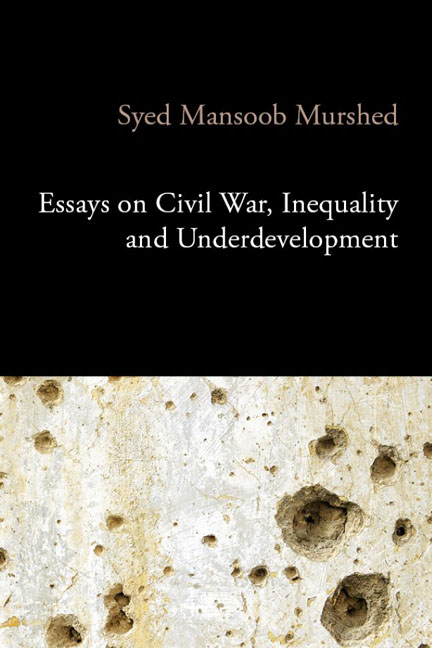Book contents
- Frontmatter
- Contents
- Preface
- Tables and figures
- 1 Conflict, civil war and underdevelopment
- 2 Revisiting the greed and grievance explanations for violent conflict
- 3 Greed, grievance and globalization
- 4 Economic dimensions of the liberal peace and its implications for conflict in developing countries
- 5 Enforcing peace agreements through commitment technologies
- 6 The conflict–growth nexus and the poverty of nations
- 7 Conflict and fiscal capacity
- 8 Does civil war hamper financial development?
- 9 The clash of civilizations and the interaction between fear and hatred
- 10 Transnational terrorism as a spillover of domestic disputes in other countries
- 11 Quantitative restrictions on the flow of narcotics: supply and demand restraints in a North–South macro-model
- 12 Spatial-horizontal inequality and the Maoist conflict in Nepal
- 13 Socioeconomic determinants of everyday violence in Indonesia: an empirical investigation of Javanese districts, 1994–2003
- 14 Not loving thy neighbour as thyself: trade, democracy and military expenditure explanations underlying India–Pakistan rivalry
- Acknowledgements
- References
- Index
12 - Spatial-horizontal inequality and the Maoist conflict in Nepal
Published online by Cambridge University Press: 09 January 2024
- Frontmatter
- Contents
- Preface
- Tables and figures
- 1 Conflict, civil war and underdevelopment
- 2 Revisiting the greed and grievance explanations for violent conflict
- 3 Greed, grievance and globalization
- 4 Economic dimensions of the liberal peace and its implications for conflict in developing countries
- 5 Enforcing peace agreements through commitment technologies
- 6 The conflict–growth nexus and the poverty of nations
- 7 Conflict and fiscal capacity
- 8 Does civil war hamper financial development?
- 9 The clash of civilizations and the interaction between fear and hatred
- 10 Transnational terrorism as a spillover of domestic disputes in other countries
- 11 Quantitative restrictions on the flow of narcotics: supply and demand restraints in a North–South macro-model
- 12 Spatial-horizontal inequality and the Maoist conflict in Nepal
- 13 Socioeconomic determinants of everyday violence in Indonesia: an empirical investigation of Javanese districts, 1994–2003
- 14 Not loving thy neighbour as thyself: trade, democracy and military expenditure explanations underlying India–Pakistan rivalry
- Acknowledgements
- References
- Index
Summary
Introduction
The landlocked Himalayan kingdom of Nepal is in the grips of a Maoist insurgency. Nepal is a low-income developing country; it also ranked 129th out of 162 countries in the composite human development index (HDI) in 2001, making it a low human development nation (see UNDP 2001). Nepal is also a new democracy; prior to 1991 it was an absolute monarchy. Nepal is composed of 75 districts across five geographical areas: Eastern, Central, Western, Mid-Western and Far Western. Each of these areas is divided into three ecological zones: mountain, hill and plain (Tarai).
The Maoist insurgency in Nepal began in 1996.1 Judging by the number of casualties, it is one of the highest intensity internal conflicts in the world at present. By November 2001 the Nepalese conflict entered into a new and more intense phase. Prior to the period of the first peace talks (July‒November 2001) the total number of casualties numbered 1593 in the ‘People's War’ or first phase of the present conflict between 13 February 1996 to 26 July 2001 (see Gautam 2001). This means that it was a medium intensity conflict, with engagements taking place mainly between the police and Maoists. After the failure of peace negotiations it has assumed the character of a high intensity conflict involving the Royal Nepalese Army (RNA). See Wallensteen and Sollenberg (2000) for the definition of conflict intensity. In Nepal there were 2,046 conflict-related deaths between 23 November 2001 and 3 April 2002. This death toll continued to mount in 2002. The civil war has also led to widespread human rights abuses (see Amnesty International 2002) including the murder, rape and torture of civilians by the RNA, extortion and the use of civilians as human shields by the Maoists.
It is the contention of this work that inter-group inequality and landlessness play a central part in motivating and sustaining the conflict in Nepal. The concept of horizontal or inter-group inequality, which is highly relevant in explaining the Nepalese civil war, has both an ethnic and caste dimension.
- Type
- Chapter
- Information
- Essays on Civil War, Inequality and Underdevelopment , pp. 197 - 212Publisher: Agenda PublishingPrint publication year: 2021



